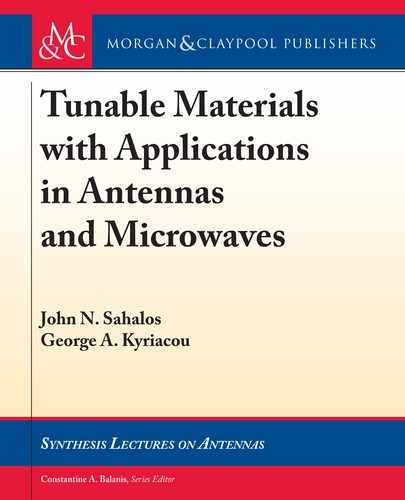
3.23. MAGNETOSTATIC SURFACE WAVES .1 C X / > 0 127
is is similar to that given in [38] even though a different notation and axis orientation
is used therein.
In order to clarify the characteristics of these modes, let us examine the particular case
in which k
z
D 0, that is, when the wave propagates only in the y-direction (transverse to DC-
magnetization).
3.23.1 MSSW PROPAGATING IN THE y–DIRECTION (k
z
D 0)
In view of the simplification k
z
D 0, expressions (3.123) reduce to
˛ D
ˇ
ˇ
k
y
ˇ
ˇ
or k
y
D ˙˛ and ˛
2
i
D k
2
y
or k
y
D ˙˛
i
: (3.151)
Recall that k
y
may be either positive or negative, while ˛ is real and positive in order to
represent exponential attenuation in the air region. In turn, the characteristic equation (3.150)
is simplified to:
2.1 CX / coth
.
˛
i
d
/
C .1 C X /
2
C 1 k
2
i
D 0: (3.152)
e trivial mathematical solution ˛
i
D 0 yields k
y
D 0, ˛ D 0 and k
z
D 0, but also in-
specting (3.149) it represents zero field. Considering expressions (3.71) for X and k
i
, the char-
acteristic equation (3.150) may be conveniently rewritten as:
2
D
2
H
C
H
C
Œ
2 C 2 coth
.
˛
i
d
/
1
: (3.153)
Again, this is like that of [13], but for ˛
i
! jk
y
j. To examine (3.153) just recall the
properties of function coth.z/ (e.g., Abramowitz and Stegun [39]), where coth.z/ 1 or
coth.z/ 1.
e first case yields the following upper frequency limit for the excitation of magnetostatic
surface waves (MSSW):
coth
.
˛
i
d
/
1 $
2
H
C
H
C
1
4
1=2
D
H
C
1
2
: (3.154)
e other option, coth.˛
i
d / 1, is not acceptable since it requires ˛
i
< 0, and this should
also be valid for k
y
as coth.k
y
d / 1. Moreover, the coth.z/ function is non-periodic; thus, there
will be only one possible solution for each specific X , namely, for each specific DC biasing of
the ferrite film. In addition, this solution will only be valid in range III, defined in (3.133c)
for frequencies above the range of volume modes. It is also clear that surface modes cannot
be excited in range I. e only possible mode can be explicitly obtained through an analytical
solution of (3.153), which, according to [12], reads as follows:
!
2
D !
i
.
!
i
C !
m
/
C
!
2
m
4
h
1 e
2jk
y
jd
i
: (3.155)
Expression (3.155) can be defined from (3.152) by considering the following identity:
coth
1
.A/ D
1
2
ln
f
.A C 1/=.A 1/
g
for A
2
> 1: (3.156)

128 3. FINITE FERRITE SAMPLES
For A D X .
In turn, the solution of (3.146) for coth gives
coth
.
˛
i
d
/
D coth
jk
y
jd
D
8
<
:
1
2
2
2
ˇ
1
9
=
;
; (3.157a)
where
2
ˇ
D
2
H
C
H
.
Let us suppose that X is equal to the right side of (3.157a) and exploit (3.156) to obtain
ˇ
ˇ
k
y
ˇ
ˇ
d D
1
2
ln
1 4
2
C 4
2
ˇ
: (3.157b)
Taking the antilogarithm and using D !=!
m
and
H
D !
i
=!
m
we go to expres-
sion (3.155). Group velocity can again be obtained through the differentiation of (3.155) with
respect to k
y
. us,
V
g
D
d!
d k
y
D
!
2
m
d
4!
e
2jk
y
jd
: (3.158)
For electrically thin slabs or films, jk
y
jd << 1, the above expression can be simplified to
1
V
g
ˇ
ˇ
ˇ
ˇ
jk
y
jd <<1
4
!
2
m
d
p
!
i
.
!
i
C !
m
/
: (3.159)
e dispersion relation (3.155) is plotted in Figure 3.19. In this figure, !=!
m
vs. jk
y
jd is
given. Moreover, the inverse of group velocity .1=V
g
/ vs. !=!
m
is presented in Figure 3.20.
0 0.4 0.8 1.2 2.01.6
1.00
0.95
0.90
0.85
0.80
|K
y
|d
ω/ω
M
Figure 3.19: Dispersion relation for MSSW in a longitudinally magnetized film [12].
e magnetic potential profile, f
i
.x/, in a direction transverse to the film is indicatively
shown in Figure 3.21.

3.23. MAGNETOSTATIC SURFACE WAVES .1 C X / > 0 129
0.850.80 0.95
1.00.90
1,000
800
600
400
200
0
ω/ω
M
1/V
g
(ns/cm)
Figure 3.20: Inverse group velocity of MSSW [12].
-2 -1 0 1 2
1.2
1.0
0.8
0.6
0.4
0.2
0
Potential (arbitrary units)
Position (units of d)
K+
K-
+ -
H
DC
Figure 3.21: e magnetic potential f
i
.x/ distribution for MSSW modes in a direction trans-
verse to the film.
Figure 3.21 reveals that any increase in ˛
i
D jk
y
j causes the mode amplitude to diminish
toward the film’s interior at a higher rate; in other words, as jk
y
j increases, the MSSW modes
cling more closely to the surface of the slab [13]. In addition, note that (3.123a) gives
˛
2
i
D k
2
y
C k
2
z
=.1 C X /: (3.160)
erefore, when k
z
¤ 0 and for the same k
y
, it is obvious that ˛
i
becomes larger and the
MSSW mode clings more tightly to the surface. Furthermore, in the limit when .1 C X / ! 0
C
,
..................Content has been hidden....................
You can't read the all page of ebook, please click here login for view all page.
